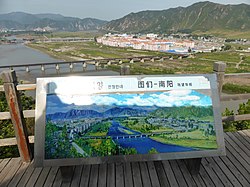A Workers' District (Munhwaŏ: 로동자구, romanized: rodongjagu in North Korea, Pyojuneo: 노동자구, romanized: nodongjagu in South Korea) is a third-level administrative division of North Korea, meaning it lies below a city or county. They are a special type of village characterized by high density residential areas located adjacent to industrial sites or special farms.[1]

Description edit
Workers' Districts were first introduced with the administrative reform of December 1952.[2] They are established in areas where there are 400 or more adult residents and where the proportion of workers exceeds 65%.[3] A Workers' District will have an administrative agency, the Workers' District Office, and an administrative organization, the Workers' District Accounting Committee.[citation needed]
Typically, they are established under a county, and there are only a few worker districts that belong to a city, such as Hamhung City's Raeil Workers' District (Korean version).[citation needed]
According to reports from the Republic of Korea Statistics Office, the total number of Workers' Districts is 314 as of 2022, an increase of 16 from 2021.[4]
References edit
- ^ Chosun Ilbo nk.chosun.com - Geography (Status of administrative districts) Archived 2006-01-09 at the Wayback Machine
- ^ "행정 구역" [Administrative District] (in Korean). Republic of Korea Ministry of Unification. Archived from the original on 2024-04-20. Retrieved 2024-04-19.
- ^ "北朝鮮、白頭山麓の三池淵郡を「三池淵市」に昇格" [North Korea promotes Samjiyon County at the foot of Mt. Paekdu to "Samjiyon City"]. Hankyoreh (in Japanese). The Hankyoreh. 2019-12-12. Retrieved 2024-04-19.
- ^ "행정구역 수". Republic of Korea Statistics Office. 2023-12-20. Retrieved 2024-04-19.